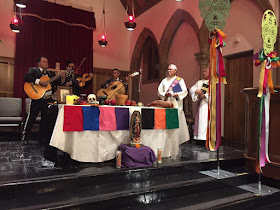Where do you get your news? I'm not surprised to learn that these days most people rely on Facebook and Twitter for their daily input. Some watch TV panel discussions on a variety of channels. Most don't bother with print media.
I do. I still am addicted to checking a wide selection of news sources daily. I've done so since my twenties when I was a high school journalism teacher. The only time I had difficulty was during the decade I lived in developing countries (1987-1997). Even then, I haunted libraries, read the international edition of Newsweek, perused old issues of Hello! and Time in used magazine shops, and kept in touch with US pop culture by getting bundles of People from my son. I always read the local newspapers, as well, in Spanish in the Dominican Republic and Guatemala, and in English and Creole in Belize and Seychelles.
In Belize I had a little TV so could get news from WGN Superchannel. In Guatemala, for a while I had access to network news via cable. In the D.R., where I lived four hours or so by chicken bus from Santa Domingo, it became a bit more difficult to tune in electronically. The Internet hadn't yet been invented, and a lot of times the electricity outages (apagones) in San Juan de la Maguana prevented me from finding any TV that worked. In Seychelles I had an hour of English news from France on Sunday afternoons...that's how I learned that Princess Diana had died.
 When I returned to the States, I started reading a daily newspaper again. I got a different slant when I lived in Little Rock than I did later in Silver Spring, when the Washington Post got deposited by a newsie...I actually supervised him at the Arkansas Department of Health, where he was a health educator and I was the state Adolescent and School Health Coordinator.
When I returned to the States, I started reading a daily newspaper again. I got a different slant when I lived in Little Rock than I did later in Silver Spring, when the Washington Post got deposited by a newsie...I actually supervised him at the Arkansas Department of Health, where he was a health educator and I was the state Adolescent and School Health Coordinator.And in NE WA I subscribed to the Spokane daily paper, and the weeklies from both Colville and Chewelah. I subscribed to both Time and Newsweek. I also tuned in to network news, PBS, and CNN.
Now I read the Los Angeles Times every evening. But additionally I get online headlines from the New York Times, the Washington Post, the Guardian, and get the Christian Science Monitor on my Yahoo news feed. I additionally get daily digests from half a dozen other sources, including the Jewish World Review, a conservative collection of opinion pieces. I check Raw Story when I want to be outraged, and even Briebart when I want to see what the latest anti-Semitic and racist rant is.
The First Amendment remains precious to me. Here it is, word for word: First Amendment - Religion and Expression. Congress shall make no law respecting an establishment of religion, or prohibiting the free exercise thereof; or abridging the freedom of speech, or of the press; or the right of the people peaceably to assemble, and to petition the Government for a redress of grievances.
 So I tend to fret when I hear threats to bar media representatives from press conferences or from access to updates on what is happening in the world. I also shiver when I hear insinuations that libel laws will be altered so fact checkers become fearful of publishing the truth.
So I tend to fret when I hear threats to bar media representatives from press conferences or from access to updates on what is happening in the world. I also shiver when I hear insinuations that libel laws will be altered so fact checkers become fearful of publishing the truth.
This is somewhat comforting:
Is truth a defense in libel lawsuits?
Truth is an absolute defense to libel
claims because one of the elements that must be proven in a defamation
suit is falsity of the statement. If a statement is true, it cannot be
false, and thereof:ore there is no prima facie case of defamation. There
are numerous jurisdictions (including Florida) that have adopted the
substantial-truth doctrine, which offers protection to a defendant of a
defamation claim as long as the “gist” of the story is true.
In the 1964 ruling New York Times v.
Sullivan, the U.S. Supreme Court held that the First Amendment protects
the publication of all statements regarding public officials unless the
statement was made with actual malice — “with knowledge of its falsity
or with reckless disregard of whether it was true or false.” The Court
set a new standard by requiring that a public-official defamation
plaintiff show evidence of actual malice by clear and convincing
evidence. If the plaintiff is a private person, then only negligence
needs to be proven, assuming the defamatory statement was false.
However, if the private person wants to recover punitive damages, she
must show that actual malice existed, as well.
http://www.firstamendmentcenter.org/faq/frequently-asked-questions-press
So could the President-elect really change libel laws in today's America? Yes, but it would be complicated. Here's some reassurance from Sydney Ember in the New York Times:
The
Supreme Court established the First Amendment principles that govern
the country’s libel laws in 1964, with its unanimous decision in New York Times v. Sullivan.
In that ruling, the court said that public officials had to prove that
false statements were made with “actual malice,” meaning news
organizations had to have knowingly published a falsehood or published
it with “reckless disregard of whether it was false or not.”
The
standard, later extended to include public figures, set a high bar for
libel and meant that people like Mr. Trump — both a public figure and
soon-to-be public official — would have a very, very difficult time
winning a libel lawsuit.
If
Mr. Trump were to seek to change the libel laws, he would have to get
the Supreme Court to overturn the ruling in Times v. Sullivan and
subsequent cases built on it, or at least chip away at either the
definition of “actual malice” or the characterization of a public
official or public figure, said Sandra S. Baron, a senior fellow at Yale
Law School’s Information Society Project and former executive director
of the Media Law Resource Center.
“A
change in those laws would require the Supreme Court of the United
States taking a new look at what it previously decided and making
changes,” Ms. Baron said. “I think there’s very little, quite candidly,
he could do short of getting the Supreme Court to overrule New York
Times v. Sullivan.”
Here's the link to the full piece: http://www.nytimes.com/2016/11/14/business/media/can-libel-laws-be-changed-under-trump.html











